Description
History is not fixed. It changes with time, shaped by the way people choose to remember or forget. In America, the story of slavery has often been softened, denied, or twisted. Yet its impact is still alive in the present. Clint Smith’s How the Word Is Passed takes readers on a journey across the United States and beyond, visiting places that hold the memory of slavery. At each stop, he asks how history has been told, and how much of it has been silenced.
The journey begins in New Orleans, a city known today for music, food, and vibrant culture. Beneath the surface, however, lies a painful past. New Orleans was once the largest slave market in America. Tens of thousands of men, women, and children were bought and sold there. Local historian Leon Waters takes visitors on tours of the city, pointing out places where this history is hidden in plain sight. Former hotels and public squares were once scenes of auctions and punishments. Streets and schools still carry the names of men who enslaved people. To Waters, the whole city itself is a monument to slavery. For Clint Smith, this realization is startling—he grew up in New Orleans but had never been fully taught about this side of its past.
From New Orleans, the book moves to Monticello, the plantation home of Thomas Jefferson. Jefferson, remembered as a founding father and the writer of the Declaration of Independence, built his life on the labor of enslaved people. He kept hundreds of men, women, and children in bondage, even as he spoke of liberty and equality. Jefferson also had a long, abusive relationship with Sally Hemings, an enslaved woman, who bore several of his children. At Monticello today, tour guides are trying to tell a fuller, more honest story. They speak not only of Jefferson’s achievements but also of the lives of the enslaved. Visitors often leave unsettled, realizing that the man they were taught to revere had built his life on exploitation.
The Whitney Plantation in Louisiana offers another perspective. Unlike most plantations that celebrate grand houses and romantic myths, the Whitney focuses on the enslaved. It displays clay statues of children, reminding visitors that young lives were taken and exploited. It recounts the brutal 1811 slave rebellion, when hundreds rose up in a desperate fight for freedom. The rebellion was crushed, and the leaders’ heads were displayed on pikes as a warning. The Whitney does not hide such truths. Instead, it shows that enslaved people were human beings with songs, games, families, and dreams. They suffered deeply, but they also resisted and created a legacy that shaped America’s culture and economy.
Another stop is Angola Prison in Louisiana, built on the land of a former cotton plantation. The prison still forces inmates—mostly Black men—to work in fields under the watch of guards, echoing the systems of slavery and convict leasing that replaced it after the Civil War. Some visitors see Angola as a tourist attraction, but Smith points out how unsettling it is: the prison profits from souvenirs while ignoring its roots in racial injustice. Many inmates earn only cents for their labor, a continuation of slavery by another name.
At Blandford Cemetery in Virginia, Smith sees rows of graves of Confederate soldiers, decorated with flags and honored with stained-glass windows. The site, like many Confederate monuments across the South, represents the story of the “Lost Cause.” This myth paints the Confederacy as noble and slavery as secondary or even harmless. But the truth is clear: the Confederacy existed to preserve slavery. Still, many Americans cling to these false stories, funding monuments and teaching a distorted version of the past.
On Galveston Island in Texas, Smith explores the origins of Juneteenth, the holiday celebrating emancipation. It marks the day in 1865 when enslaved people in Texas finally learned they were free—two years after Lincoln’s Emancipation Proclamation. Yet even after that day, freedom was uneven and delayed. Many enslavers hid the news, and many freed people were left without land, money, or support. Juneteenth became a tradition of celebration but also reflection. It asks America not only to cheer freedom but to ask what freedom really means when inequality still exists.
In New York City, Smith joins a walking tour of the city’s slave history. Many northerners believe slavery was only a southern issue, but New York thrived because of it. Enslaved people built much of the city. Wall Street itself was once a slave market. Even the banks and businesses that later powered America’s economy were tied to slavery. Today, places like the African Burial Ground remind New Yorkers that the city was built on Black labor and Black suffering. Even the Statue of Liberty carries this history—hidden beneath her robe are broken chains, meant to symbolize the end of slavery.
The journey then crosses the ocean to Gorée Island in Senegal, one of the points where Africans were forced onto ships bound for the Americas. The House of Slaves, with its “Door of No Return,” has become a symbol of this tragedy. Millions of tourists and leaders have visited it, standing in silence where enslaved people were once held. Some details about the site may be exaggerated, but the power of the memory remains. Whether thousands or millions passed through, even one life lost to slavery is too many.
The book closes with Smith turning to his own family. He learns that his grandfather’s grandfather had been enslaved. Walking with his grandparents through the National Museum of African American History and Culture, he listens to their memories of segregation, fear, and resilience. His grandmother remembers being forced to the back of buses and living through racial violence. His grandfather remembers night riders and lynchings. Their lives show that the story of slavery is not ancient history—it touches the present and lives within families.
How the Word Is Passed reminds us that history is not only about the past but also about the present. The way we choose to remember—or forget—slavery shapes the way we live today. Confederate monuments, prison labor, racial inequality, and even everyday myths all stem from the failure to fully confront the truth. Clint Smith shows that memory is powerful. By facing the full story, painful as it may be, we open a path toward justice, empathy, and healing.





